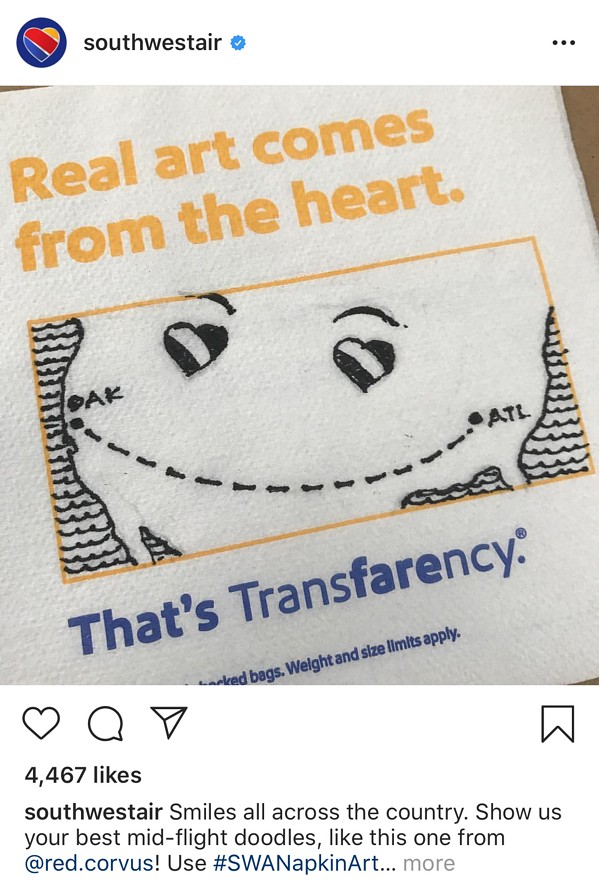I fly Southwest Airlines almost exclusively. They offer reasonable prices, make it easy to rack up points, and always have fun and kind flight attendants.
One thing I’ve noticed about Southwest is their branding is on point. Whether I’m booking a flight on their mobile application, being served my go-to in-flight ginger ale, or walking through the terminal at Midway Airport, I’m surrounded by Southwest’s consistent brand colors, messaging, and imagery.
This is an example of integrated marketing at work. If you’re interested in presenting a cohesive, consistent brand experience that leaves your products or services top-of-mind — like Southwest does — this guide is for you. Read on to learn more about integrated marketing and how to create a campaign of your own.
Imagine discovering a new brand on Instagram and visiting the company’s website to purchase one of their products. If their website promoted a different message or campaign than the one you found on their Instagram account, you’d have a hard time understanding the gist of the brand, right?
Integrated marketing exists to eliminate these disparities and differences regardless of how or when a customer interacts with your brand. It’s similar to multi-channel marketing, except integrated marketing is what aligns the message you’re sharing on all of those channels.
Speaking of channels, integrated marketing doesn’t apply to just your inbound or digital marketing channels; traditional media channels are also included. Many of the integrated marketing examples we’ll review below incorporate traditional marketing channels such as print, radio, and TV ads.
Now, let’s talk about integrated marketing campaigns.
Why are integrated marketing campaigns effective?
While integrated marketing campaigns can differ in their goals (e.g. converting views, building brand awareness, etc.), they should all have one component in common: to align your marketing channels to present a united marketing “front”.
If your marketing channels are players, consider your integrated marketing campaign the coach in charge of running plays and helping your channels work as a unified system — not disparate ones.
It’s also more effective to run integrated marketing campaigns as compared to campaigns on individual channels. Integrated marketing campaigns are impactful for a few reasons:
- They reach a wider audience than a single marketing channel.
- They have a greater chance of being seen on multiple channels, thus keeping your brand top-of-mind and pushing visitors closer to conversion.
- They build trust with visitors as they see a consistent message on multiple channels.
- They save you money since assets can be shared between and repurposed for different marketing channels and, depending on your campaign, customers can help you market your product or service for you.
So, how can you build your own integrated marketing campaign? Follow these steps to get started.
1. Establish your overarching campaign goal.
Before you consider what channels will be part of your integrated marketing campaign, you must consider the goal of the entire campaign.
Maybe you’ve launched a new product, service, or initiative and want to get it in front of customers — like Southwest’s Transfarency. Maybe you’ve completely rebranded and want to broadcast your new message — like Old Spice’s Smell Like a Man, Man. Perhaps you’ve simply chosen a new positioning tagline and want your audience to start associating your brand with it — like Snickers’ You’re Not You When You’re Hungry.
(Don’t worry, we’ll dig deeper into these examples later.)
Whatever your campaign goal may be, always remember to make it SMART. This will help you stay focused, track your campaign success, and learn how to improve the next time around.
These goals should also relate to at least one of the following key performance indicators (KPIs) and their subsequent metrics, which you can track when you launch your campaign.
| KPI | related Metrics |
| Traffic/reach | Unique page views by channel and source |
| Engagement | Bounce rate; average time on page |
| Top (and falling) content | Top page views; top exits |
| Impact | Click-throughs; conversions; backlinks |
| Sentiment | Comments; social shares |
| Lead generation | Total leads; total sessions; session to lead conversion rate |
| Sales | Lead to marketing qualified lead (MQL); MQL to sales qualified lead (SQL); customer purchase/closed-won business |
Also, while increased engagement and new leads are always exciting, a multi-channel campaign should also consider the bigger picture: how your campaign impacts sales opportunities and business revenue. Take a moment to map out how you want your campaign to impact your bottom line, too.
2. Choose your marketing channels and set goals for each one.
Now that you know your overarching integrated marketing campaign goal, you probably have a better idea of what channels (if not all of them) can help you reach that goal.
For example, if your goal is to roll out a new logo and branding suite, you don’t necessarily need to leverage radio ads. On the other hand, if you’re extending your audience to target a new geographic region or city, radio ads, billboard ads, TV ads, and other local channels may come in handy.
When choosing your channel(s), it all boils down to what you’re trying to achieve through your integrated marketing campaign. There are 10 major marketing “channels” that you can use to distribute your campaign content.
- Advertising (both print and PPC)
- Direct marketing
- Email marketing
- PR
- Personal selling
- Sales promotions
- Digital marketing (e.g. website, content marketing, and SEO)
- Social media
- Events and sponsorships
- Packaging
Your integrated marketing campaign should include a variety of marketing channels in order to reach the widest audience and drive home your campaign message. If you see one or more channels plateau, don’t hesitate to add, remove, or test new ones.
3. Define your buyer personas by channel.
Every marketing channel targets its own specific buyer persona. For this reason, instead of defining a broad persona for your campaign, you must define your audience by channel.
There will inevitably be some overlap, but it’s wise to understand exactly who you’re talking to on each medium and how you can tailor those specific assets to be the most successful.
Note: With some campaigns, you may be targeting a specific audience. In this case, steps 2 and 3 would be flipped — you’d define your buyer persona(s) first and then decide which channels can help you reach that audience.
4. Identify your channel managers.
Depending on the size of your marketing team, you may have different people (or entire teams) in charge of different channels. When running a multi-channel marketing campaign, you must determine who specifically will be in charge of ensuring their channel(s) is aligned with the campaign.
This is important for two reasons: 1) that manager is the expert on their channel (e.g. audience, posting cadence, optimization tactics, reporting strategies, etc.) and will know how to tailor the campaign content to be the most successful; and 2) putting one person in charge of all channels may be overwhelming and will cause the content and campaign to suffer.
Perhaps you have a smaller marketing team where one person handles multiple channels. Regardless of your team size, do your very best to share channel management responsibilities across a few people — ideally with one person handling one or two channels.
5. Create adaptable marketing assets and messaging.
At this point, you have your campaign goal, target audience(s), and marketing channels. It’s now time to create your integrated marketing campaign content. This stage is where copywriting, graphic design, and other creative processes come into play.
Before I dive into how, let’s talk about an important component of integrated marketing content: adaptability. To keep your campaign consistent (and ease your workload), you should be able to repurpose any content to be used on different channels.
For example, let’s say your integrated marketing campaign is focused on the launch of a new 3-minute brand video. You could repurpose this video into:
- 30-second and one-minute “trailer” videos
- Still images
- Quotes
- GIFs
- Hashtags
- Blog posts
- Soundbites
As you develop and repurpose these creative assets, keep them aligned with your brand guidelines and consistent with each other. In fact, it may be helpful to create your own set of brand guidelines for your integrated marketing campaign to share with your team and any channel managers.
This documentation could include a few things:
- Visual guidelines (logo, color palette, typography, etc.)
- Any developed and repurposed assets in multiple file formats
- Voice and tone guidelines (taglines, preferred language, words to avoid, etc.)
- Messaging guidelines (pain points, goals, types of content, resources, etc.)
- Buyer persona information and guidelines
Integrated marketing is all about a consistent brand experience. Be sure your campaign assets reflect that, regardless of what channel your audience visits or sees.
6. Establish your plan for collecting leads.
Whether or not you intend your campaign to collect leads, you should always be prepared to receive them. You don’t want to leave this as an afterthought once you launch your campaign. Even if you’re simply campaigning to raise awareness of your brand, consider how your visitors might convert to leads — and, eventually, customers.
First, consider how a visitor might convert to a lead. Would they subscribe to your newsletter? Input their information to download a content offer? Create an account on your website? Ensure these conversion aspects of your campaign are also on-brand with the rest of your visual and messaging assets.
Next, consider how your leads will be nurtured once they convert. Would they roll into an automated email workflow? Would you pass them along to Sales? However you go about this step, make sure your leads aren’t forgotten once they willingly give over their information.
As always, communicate with Sales to confirm that they’re aware of your campaign and on-board with your plan for new leads and customers.
7. Launch, measure, and iterate your campaign.
Ready to launch your integrated marketing campaign? It might be time to put your campaign to work … but it’s not time to rest just yet.
Remember those KPIs and metrics from step one? Whichever KPIs relate to your overarching campaign goal (e.g. boosting brand awareness, rebranding, new product, etc.), start tracking those subsequent metrics each week, month, and quarter (depending on how long your campaign is running) to see how successful it is at reaching your goal.
As always, take what you learn from each integrated marketing campaign and apply it to future campaigns. With the right strategies, managers, and tools in place, you can create a never-ending cycle of integrated marketing campaigns — and wins.
Integrated Marketing Strategies and Best Practices
As you construct your integrated marketing campaign, there are a few key strategies and best practices to keep in mind. We’ve detailed them here, and they apply regardless of what media, channels, or goals you’ve chosen.
Align behind the scenes.
In order for you to successfully implement an integrated marketing approach, it’s imperative that you not only choose marketing channel managers but that all your marketing managers also communicate often about projects and campaigns.
While not every integrated marketing campaign or promotion needs to be on all of your channels, they should at least complement each other to avoid a fragmented brand experience for customers.
Consider the channel transition.
Integrated campaigns receive traffic from a number of sources — and pass along those sources like a game of Hot Potato. Consider how a visitor may view/experience each marketing channel 1) if it was their first visit and 2) if they transitioned from another channel. Think about how each channel can help others convert.
For example, say a customer saw your new billboard on their way to work and, once they arrived, visited the website that was on the billboard. Imagine if, on your website, the customer couldn’t easily find whatever your billboard was marketing. How confusing would that be? That customer would likely drop off immediately.
Don’t neglect the small overlaps.
When preparing to launch your integrated marketing campaign, it’s tempting to separately think about each channel and its respective media assets. But this thought process inherently goes against the ethos of integrated marketing. Integrated marketing exists to eradicate the silos of traditional marketing and bring together a cohesive campaign experience.
For this reason, don’t neglect the places in which your campaign overlaps. Here are a few examples:
- Your email signature, where you can plug your social media handles, website URL, or video links
- Your social media bios and posts, where you can include links to your website, blog posts, content offers, or other digital content
- Your blog and website, where you can incorporate social sharing buttons
- Your standalone landing pages, where you can optimize for relevant keywords and SEO
- Your PPC copy, where you can test subject lines to see what your audience responds to
While these overlaps might not directly support your campaign goals, they help your audience transition seamlessly between channels, enjoy that consistent, cohesive brand experience, and ultimately find their way to a page that converts them.
Every marketer knows just how much you can learn from those who’ve come before you. In this section, we’ve pulled together a handful of well-executed integrated marketing campaigns to give you an example of just how successful this tactic can be.
1. Smell Like a Man, Man by Old Spice
For years, I associated Old Spice with something only my dad or grandfather would wear. I can remember the old, white bottle of aftershave — the one with the faded pirate ship — that used to sit in my dad’s cabinet.
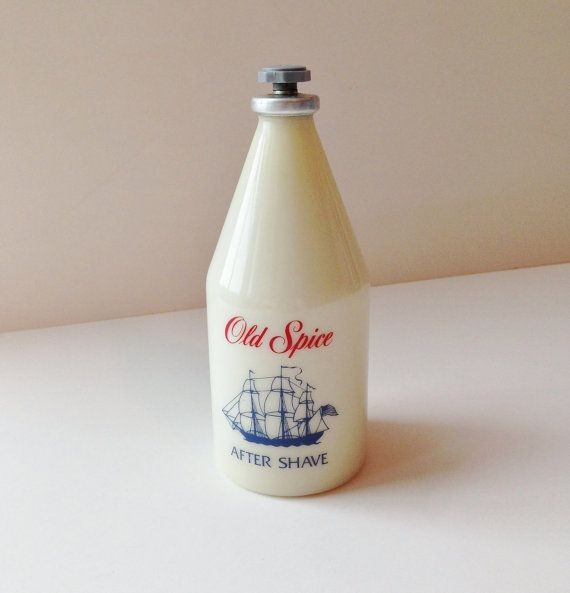
The initial campaign launch featured one 30-second TV spot, The Man Your Man Could Smell Like, that was so beloved that Old Spice launched a handful of others.
But Old Spice didn’t stop at the TV commercial. They also included their website, product pages, Instagram, YouTube, and other channels in their campaign.
No, they don’t all feature the specific characters or taglines from the original TV spots (remember, the campaign launched almost 10 years ago), but they do reflect the same tone, theme, and brand, thus giving customers a consistent brand experience across all media.
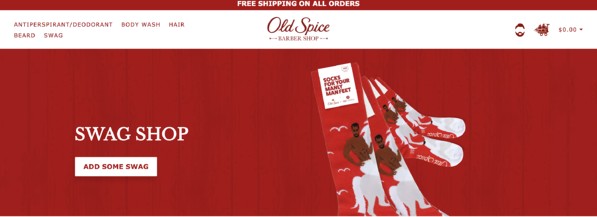
2. Transfarency by Southwest Airlines
I discussed Southwest Airlines' consistent branding at the beginning of this article. One campaign that stands out is their Transfarency movement, which introduced a brand new word that marketed Southwest as an airline with straightforward pricing and no hidden fees.
The campaign originally launched in 2015, but Southwest has since been rolling out phases to release new elements and introduce more themes and stories. This tactic has helped elongate the campaign message and truly solidify the association between flying Southwest and saving money on fares.
Southwest has used almost every possible marketing channel to broadcast this campaign: a dedicated landing page on which you can purchase tickets, print advertisements posted along airport walls and tucked behind airplane seats, a slew of video spots, and plenty of user-generated content on their social media.
3. You’re Not You When You’re Hungry by Snickers
Snickers is one of my favorite chocolate bars, so I paid close attention when I started to see commercials for their You’re Not You When You’re Hungry advertisements.
Launched at the 2010 Super Bowl, this Snickers campaign has remained top-of-mind for chocolate and candy lovers everywhere.
One reason for this is the campaign’s humor, but the other, more pertinent reason is that Snickers pasted this movement everywhere … on its website, social media, TV, print ads, and more, and they included plenty of celebrities to boot. By presenting an aligned, cohesive integrated marketing campaign, customers now think of Snickers when craving a sweet snack — and the company has benefitted as a result.
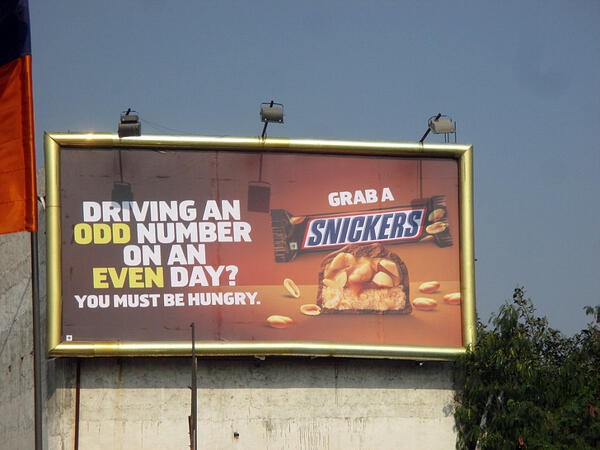
4. Share a Coke by Coca-Cola
Coca-Cola's Share a Coke campaign was unique in that the company put their customers front and center by featuring names and fun phrases on their product. Not only did this create endless advertising angles, but it led to endless user-generated content from customers wanting to share products with their own name. The #ShareaCoke hashtag was shared via 500,000+ customer photos.
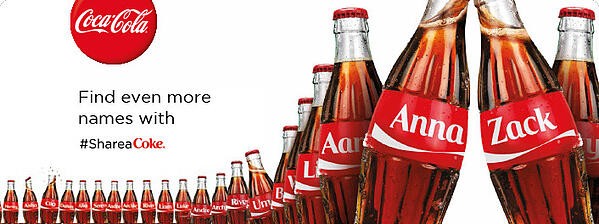
When this campaign was at its height, I found myself taking pictures of and even buying Cokes featuring the names of my friends and family. It seems that others did the same — the campaign resulted in an increase in Coke consumption from 1.7 billion to 1.9 billion daily servings.
5. Grow Better by HubSpot
HubSpot has countless digital properties — its blog, website, social media channels, and SaaS products. This level of variety requires a lot of consistency in messaging and marketing.
HubSpot recently set its ultimate vision to help customers grow better — all customers, on all channels. To promote this messaging, it updated all content to reflect this vision.

The message may be short, but the impact is big. However and wherever customers interact with HubSpot, its integrated marketing has ensured that they know how HubSpot operates — and why they should become a customer.
Integrated Marketing Helps You Grow Better
Integrated marketing turns your marketing campaigns into multi-channel movements. In today’s omnichannel world — with consumers encountering your brand online, on social media, and on their daily commutes — integrated marketing is more important than ever to capture new customers and build brand recognition and loyalty.
Implement these steps and strategies for your next integrated marketing campaign, and it will surely be a success.
Editor's note: This post was originally published in October 2019 and has been updated for comprehensiveness.

